Companion planting is not a new horticultural concept. This technique has been used for as long as humans have been farming and is often employed for agricultural purposes. That being said, rose gardeners have since discovered companion planting has great use outside of agriculture.
Certain plants make other plants better overall by lowering pests and luring helpful insects. However, in other circumstances, companion planting may be used only because particular plants look excellent when grown together. This is especially noticeable with roses and other flowers.

Roses are beautiful as standalone plants in any setting, but occasionally you might wish to freshen things up. Planting flowers or herbs that benefit and complement your rose bushes is the best method to do this. Fortunately, there are several plants out there that may actually help your roses’ health while also looking great next to them.
Let’s take a look at some of the best companion plants out there for roses. But first, let’s break down what companion plants are in more detail.
What Are Companion Plants?
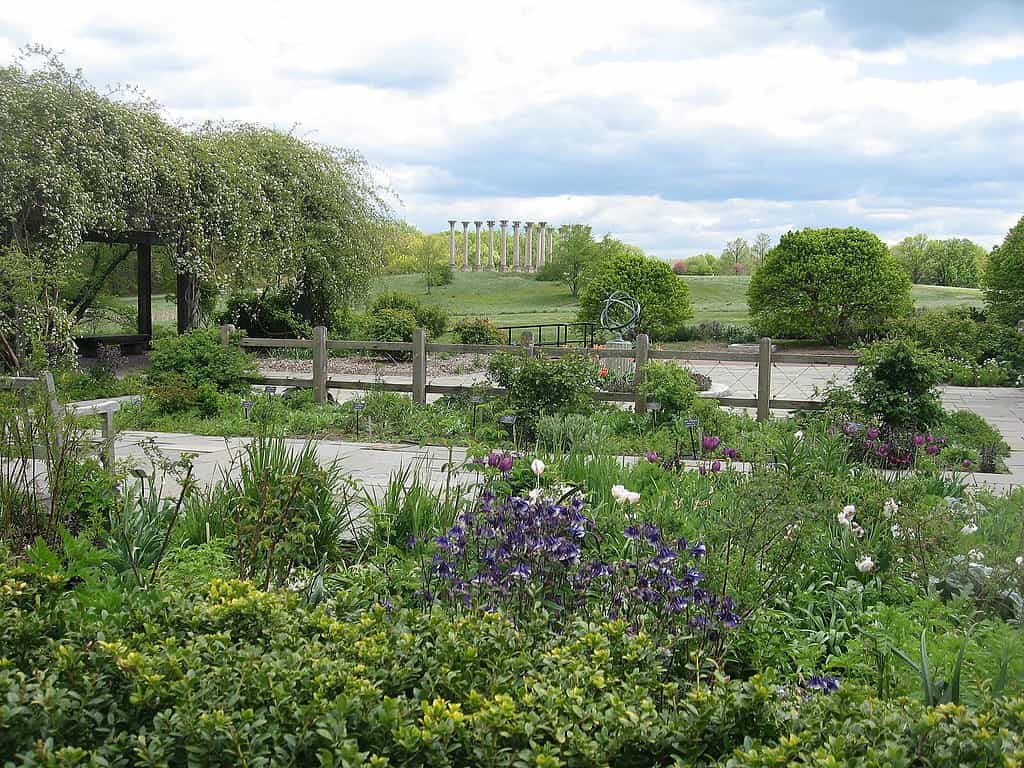
Plants can be mutually helpful to one another.
©DC Gardens, CC BY 2.0 – License
Plants that are planted together for mutual benefit are known as companion plants. Based on their complementing traits and the benefits they may provide to each other’s development and health, they are purposefully planted next to one another. This method can be used for growing crops as well as roses.
Companion planting is a great way to start controlling pests. Certain companion plants can ward off or scare away pests, defending nearby plants. For instance, marigolds are frequently planted next to vegetables to ward against pests since their strong aroma repels a variety of insects.
Another advantage of companion planting is the avoidance of disease. Some companion plants have innate defenses against infections or the ability to decrease sickness. To protect tomato plants from pests and illnesses, for instance, one should put basil close to tomatoes.
An increase in soil nutrients is another advantage. Some plants have vast root systems or deep taproots that may reach nutrients deep within the earth. By helping to raise nutrients to the surface, these plants can make them accessible to neighboring plants with shallower roots. Beans and peas and other legumes are well recognized for their capacity to fix nitrogen in the soil, which benefits nearby plants that need nitrogen.
The Benefits of Companion Planting
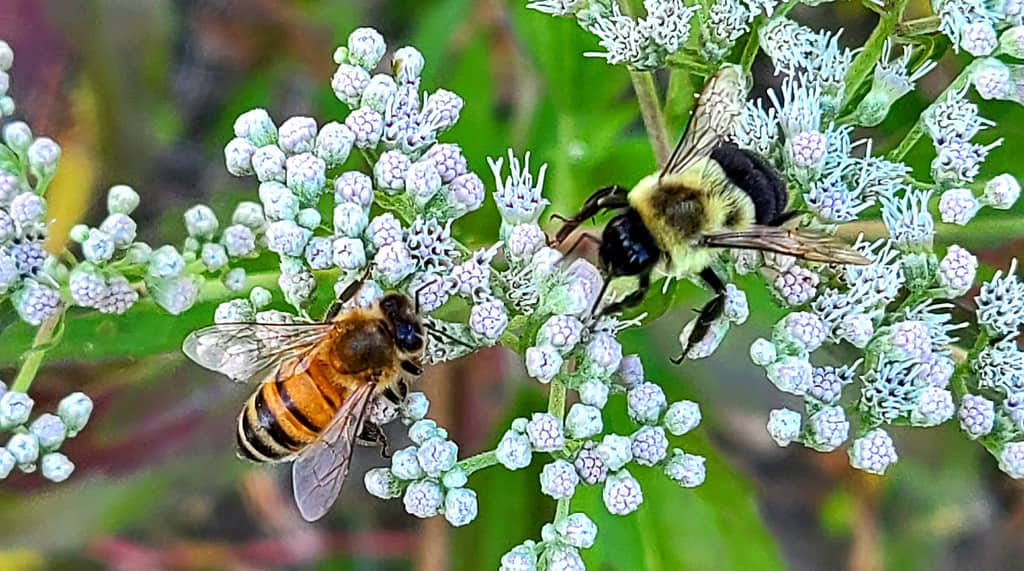
A Western
Honey Bee
(left) and a Common Eastern Bumble Bee (right) gathering nectar from the same patch of Boneset flowers.
©Sarah Bruce/iStock via Getty Images
Companion planting can draw beneficial insects, such as bees and butterflies, which are necessary for pollinating many plants. This results in better pollination. Planting flowers next to vegetable crops, for instance, can assist draw pollinators, which can enhance fruit set and output.
Some companion plants have the ability to cover the soil and inhibit the growth of weeds by acting as living mulches. They may outcompete weeds for nutrients, sunshine, and other resources, which eliminates the need for laborious weeding.
A few companion plants also offer beneficial insects, birds, and other creatures a home and environment. With natural predators controlling insect populations, this can contribute to the development of a more balanced ecology in the garden.
When grown close together, certain plants exhibit growth-promoting or flavor-improving benefits. Planting fragrant herbs like rosemary or thyme close to specific vegetables, for instance, might improve the flavor of those veggies.
Companion planting, to put it simply, is a time-honored gardening technique that makes use of the synergistic interactions between several plant species. While minimizing the need for pesticides and artificial fertilizers, it can also help build a healthier and more fruitful garden.
With a solid idea of what companion plants are in mind, let’s take a look at some of the best companion plants to grow with roses!
1. Snapdragons
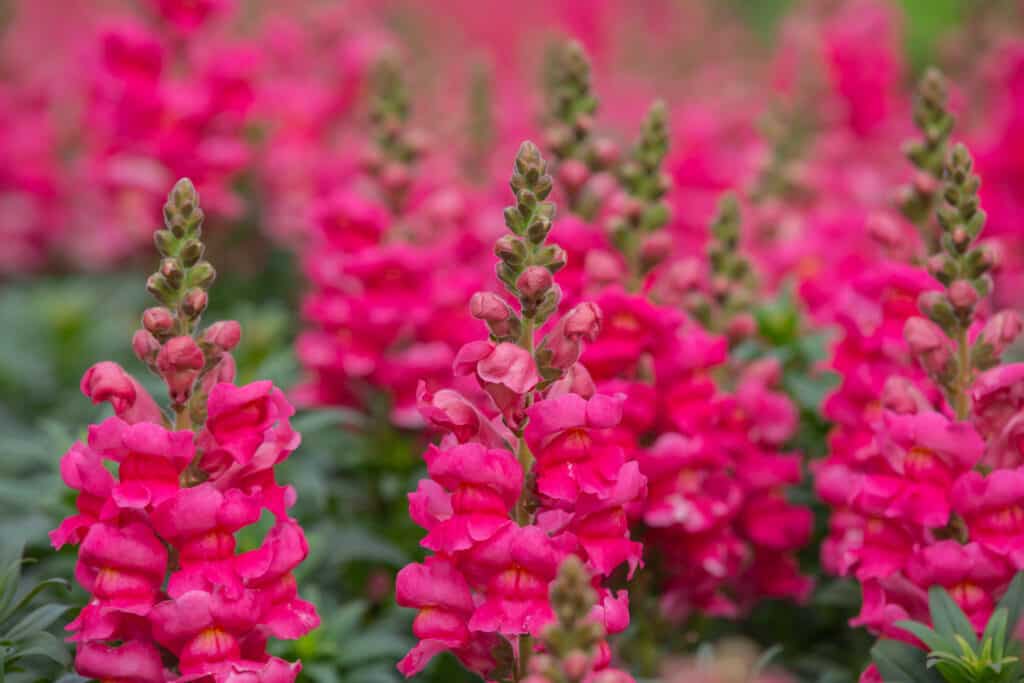
Snapdragons (pictured) come in similar colors to roses.
©271 EAK MOTO/Shutterstock.com
Classification: Antirrhinum majus
For a number of reasons, snapdragons are great rose companions. First off, their tall stature and upright growth pattern offer the perfect backdrop for the expansive and frequently bushy rose bushes. The towering flower spikes of snapdragons, which come in a variety of hues, provide a pleasing visual contrast and improve the overall appeal of the rose garden.
The pollination of roses depends on the presence of helpful insects like bees and hoverflies, which are attracted to snapdragons. These pollinators are drawn to the garden by the nectar-rich flowers on which they feed, which serve as a crucial food source. Increased fruit set and greater overall rose yield can result from improved pollination.
Snapdragons’ capacity to serve as a sacrifice plant is another factor in their value as rose companions. Pests that frequently attack roses, such as aphids, find snapdragons to be particularly alluring. Snapdragons can assist in preventing infection and lowering the danger of harm to the roses’ foliage and blossoms by drawing aphids away from them.
Additionally, snapdragons can shade the area surrounding the rose bushes and serve as a sort of living mulch. Their thick foliage can aid in weed suppression and moisture retention in the soil, improving the roses’ growing conditions.
2. Sage
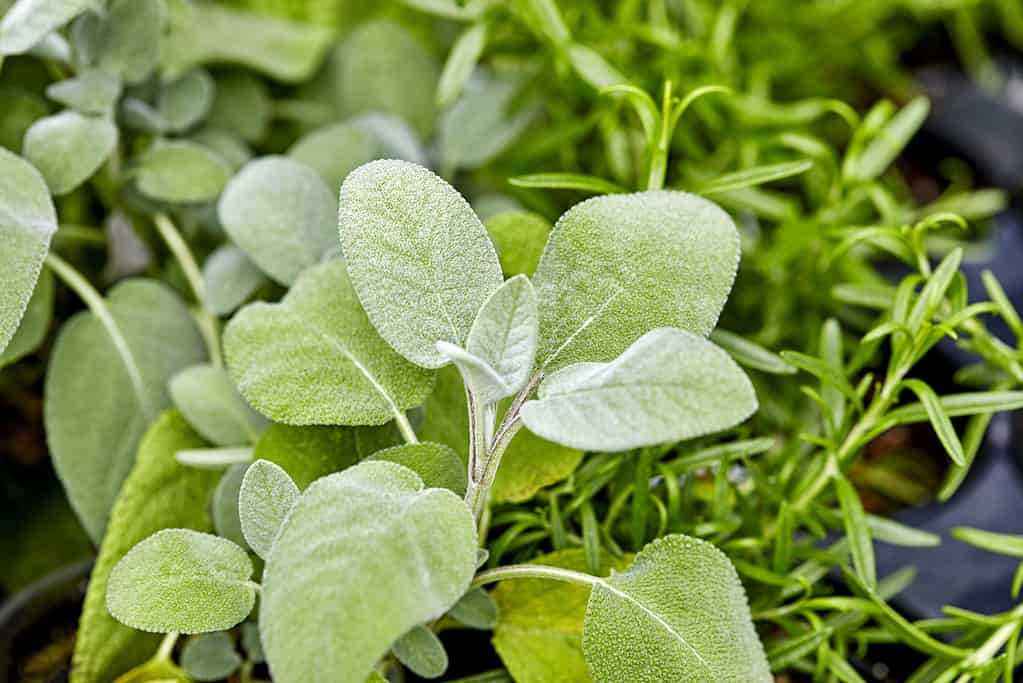
Sage (pictured) is beneficial for both roses and the soil they share.
©iStock.com/wingedwolf
Classification: Salvia officinalis
Sage is an excellent rose companion plant, providing a number of benefits that improve the general health and well-being of the rose garden. Sage first and foremost serves as a natural pest repellent. Aphids, cabbage moths, and carrot flies are just a few of the typical pests that its strong perfume, which is generated from its essential oils, wards off. Sage may help defend roses against these pests and lessen the chance of infection by being planted close to them. This will lead to healthier roses with less damage to their foliage and blossoms.
Additionally, sage’s stunning petals and nectar-rich blooms draw pollinators like bees and butterflies. These pollinators are very important for fertilizing roses, which results in better fruit growth and more roses being produced.
The soil around roses can also benefit from the addition of sage. With the aid of its deep root system, compacted soil may be broken up, increasing drainage and enabling air to reach the roses’ roots. Sage is also known to store minerals like calcium and potassium, which can be advantageous for the expansion and development of roses.
Lastly, sage’s thick foliage acts as a natural weed barrier. Sage may be grown next to roses to help control weed development, lessen competition for resources, and guarantee that roses have enough water, nutrients, and sunlight.
3. Lavender
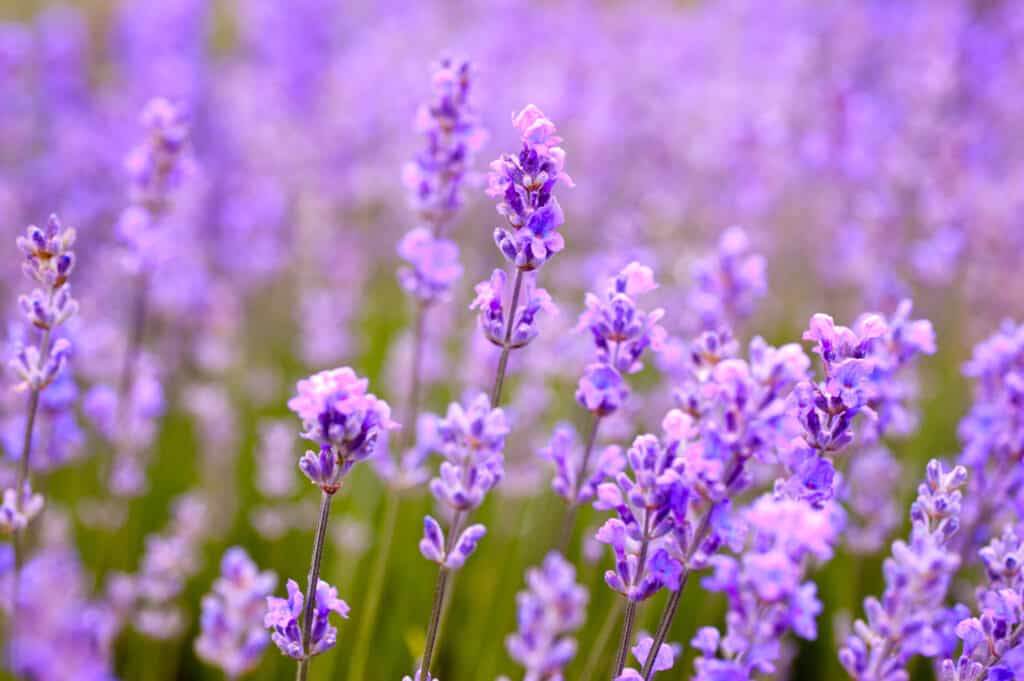
The purple hue of lavender (pictured) contrasts well with the colors of roses.
©reya-photographer/Shutterstock.com
Classification: Lavandula genus
With many advantages that support the general health and vitality of the rose garden, lavender is a superb companion plant for rose gardens.
With its aromatic and nectar-rich blossoms, lavender attracts helpful pollinators, particularly bees and butterflies. Gardeners can improve pollination and encourage an abundance of blossoms by growing lavender close to roses.
Just as well, lavender has natural insect-repellent qualities that help keep away pests that might damage roses. Pests including aphids, moths, and fleas are deterred by the strong scent of lavender. Lavender can help protect roses from insect infestations in a rose garden, lowering the need for chemical treatments.
The compact and bushy growth style of lavender offers a pleasing aesthetic contrast to the expansive growth tendency of roses. Lavender’s vivid purple, pink, or white blooms blend nicely with roses’ hues to provide a visually appealing and harmonious garden show.
The fragrant leaves of lavender can help conceal the fragrance of roses, perhaps confounding pests that use scent to find their prey. This can help the roses blend in with their surroundings and deter pests from eating them.
It’s also worth noting that lavender has the power to enhance soil quality. Its root structure contributes to better drainage and lessened soil compaction, which benefits roses by fostering a more favorable growth environment.
4. Parsley
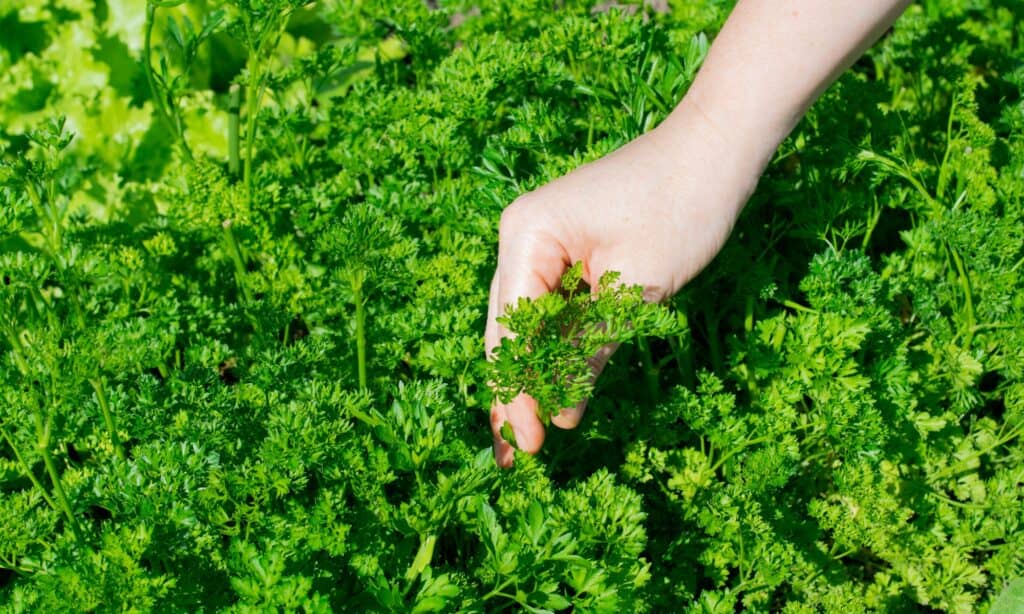
Parsley (pictured) is known for being an excellent pollinator insect attractor.
©iStock.com/Oksana Chaun
Classification: Petroselinum crispum
Even though it might not seem like a natural choice, parsley can nonetheless benefit the rose garden in a number of ways. To start, parsley draws helpful insects that naturally eat pests like aphids and other pests, such as hoverflies and parasitic wasps. Planting parsley close to roses will aid in attracting these helpful insects, improving the ecosystem’s equilibrium and lowering the likelihood of pest outbreaks.
The lacy leaf of parsley can serve as a natural mulch, retaining moisture in the soil and inhibiting weed development. Parsley may assist create a more suitable environment for rose plants by covering the soil around them, ensuring they get enough water and nutrients.
Additionally, parsley has the capacity to store nitrogen in its leaves, which is advantageous for surrounding plants like roses. Nitrogen is a crucial component for plant growth that encourages strong overall growth and healthy foliage. Growing parsley distributes nitrogen into the soil, enriching it and giving the roses a boost in nutrients when it ultimately decomposes.
Parsley may also be used in the rose garden as a companion plant to give visual variation and interest. By providing a pleasing contrast to roses’ expansive growth habits and vivid green foliage, it improves the garden’s overall attractiveness.
5. Alyssum

Alyssum (pictured) plants don’t take up a lot of room, making them great for small rose gardens.
©iStock.com/Sundry Photography
Classification: Lobularia maritima
Alyssum is a fantastic rose companion plant, offering a variety of benefits that enhance the general health of the rose garden.
First off, alyssum’s beautiful and fragrant blossoms draw helpful insects like bees and hoverflies. A rose garden will flourish if gardeners place alyssum next to the roses to improve pollination.
Additionally, alyssum serves as a natural ground cover that inhibits the growth of weeds. By shading the soil and creating a living mulch, its dense and slow-growing leaves lessens competition for resources like sunshine, water, and nutrients. Minimizing weed interference not only preserves the rose garden’s tidiness but also promotes the growth of the roses.
Alyssum also attracts pests away from the roses and serves as a trap crop. Common bugs called aphids can harm rose leaves and spread illnesses. It can safeguard the roses by deterring pests from the roses and lowering the likelihood of infestation by enticing aphids to the alyssum blossoms.
Lastly, alyssum has a shallow root system that doesn’t put up much of a fight for nutrients with roses. Because it does not deny the roses of necessary resources, allowing them to develop and thrive, this makes it the perfect companion plant.
6. Lady’s Mantle
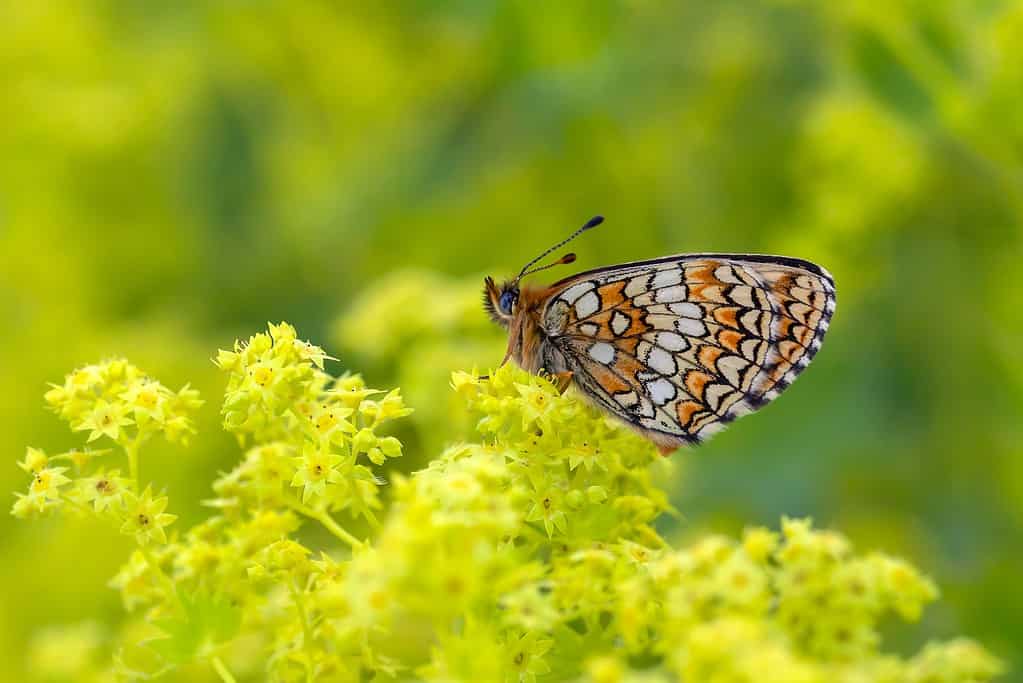
Lady’s mantle (pictured) is an excellent pollinator plant.
©Kenan TALAS/Shutterstock.com
Classification: Alchemilla mollis
The benefits that lady’s mantle provides to the general health and attractiveness of the rose garden make it a great companion plant for roses. First off, lady’s mantle has a lovely and unique appearance that goes well with the roses’ delicate beauty. It adds aesthetic appeal to the landscape with its rounded, pleated leaves and clusters of small, chartreuse blooms.
In addition to serving as a natural ground cover, lady’s mantle creates a dense carpet of leaves that inhibits weed development around the roses. The roses may flourish because the soil is covered, which lessens competition for resources like water, nutrients, and sunlight.
Deep roots of lady’s mantle help to enhance soil structure and encourage improved water drainage. Its roots can aid in loosening up compacted soil, which will promote root penetration and aeration for the roses.
Lady’s mantle leaves have the unusual ability to trap water droplets that resemble tiny diamonds after rain or irrigation. Specifically during dry seasons, this water-retaining feature can aid to hydrate the surrounding soil and maintain moisture availability for the roses.
The potential of lady’s mantle to draw helpful pollinators like bees and butterflies is well recognized. These insects are essential for pollinating roses, as we have already indicated.
7. Marigolds
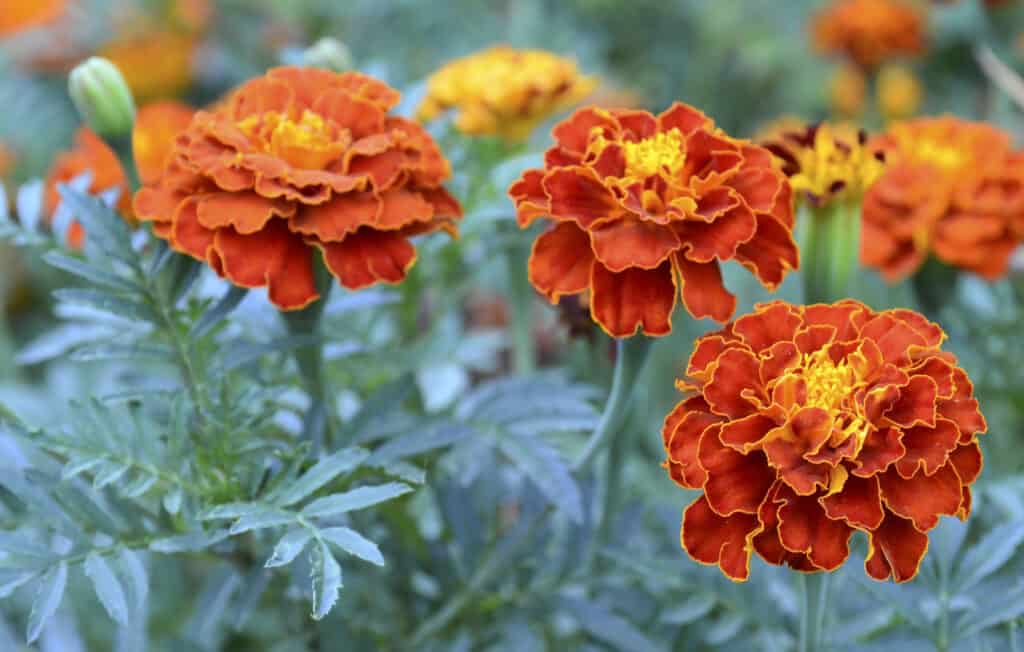
Marigolds (pictured) are very rose-like and well-suited for a rose garden.
©iStock.com/svf74
Classification: Tagetes genus
Marigolds are excellent rose companion plants, providing a number of benefits that enhance the general well-being and vigor of the rose garden.
Ladybugs and lacewings, two beneficial insects that naturally eat aphids and other plant pests, are drawn to marigolds. These helpful insects provide a better ecology in the rose garden by assisting in the management of pest populations.
Marigolds can prevent the growth of weeds as well. They shade the soil and lessen competition for resources like water, nutrients, and sunshine because of their thick foliage and robust growth habits. This reduces weed interference and helps to produce a suitable habitat for the roses.
These vibrant flowers offer vivid, brilliant blossoms that enhance the rose garden’s attractiveness and aesthetic appeal. Their vibrant blossoms contrast the roses in a lovely way, boosting the garden’s overall attractiveness.
Marigolds also grow easily and need little maintenance. They make good rose companions since they are sturdy plants that can endure a variety of soil types and flourish in full sun.
8. Feverfew
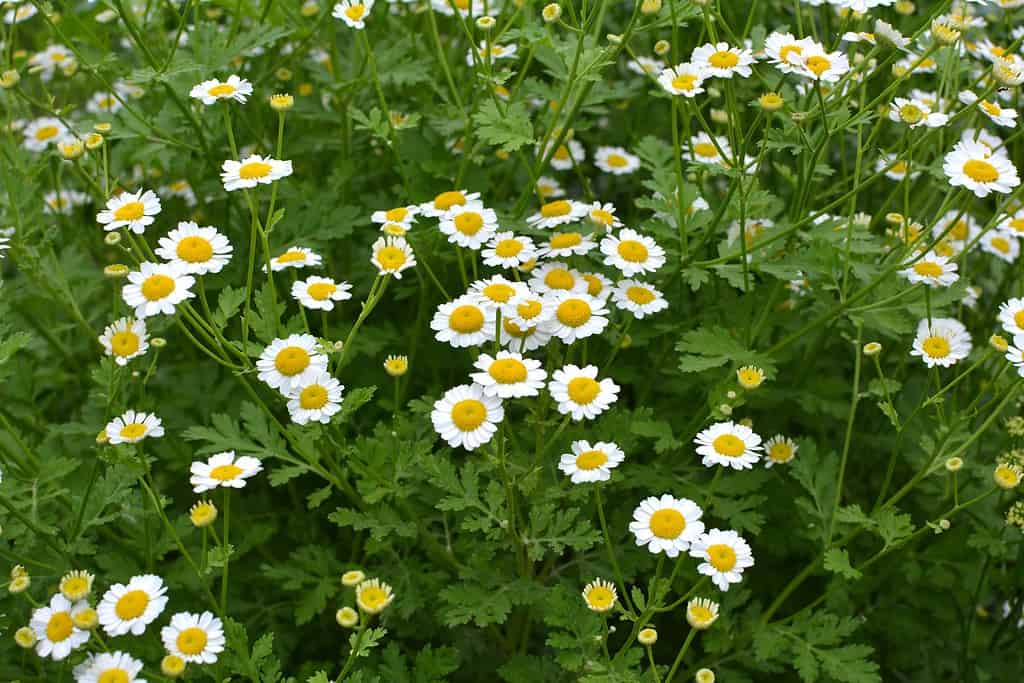
Feverfew (pictured) has a daisy-like quality that makes it great for flower gardens.
©Orest lyzhechka/Shutterstock.com
Classification: Tanacetum parthenium
Due to its many advantages, feverfew makes a wonderful rose companion plant. Its tiny, daisy-like blossoms draw helpful insects. These insects include ladybugs, lacewings, and hoverflies, which eat pests that might harm roses, such as aphids. Feverfew helps maintain a natural balance in the garden. It also lessens the need for artificial pesticides by luring these helpful insects.
The fragrant leaf of feverfew has a smell that keeps insects like gnats and mosquitoes away, giving roses extra defense. This inherent pest-repelling property keeps the roses healthy and reduces the likelihood of infections.
In contrast to the expansive nature of roses, feverfew’s confined growth pattern and delicate, fern-like leaves provide an attractive aesthetic contrast. The garden is made more beautiful overall because of this contrast, which gives it depth and appeal.
Feverfew is a relatively low-maintenance plant that is simple to grow next to roses. It has benefits for both pest management and aesthetics. It is a suitable and hassle-free companion for roses since it tolerates a variety of soil types and may flourish in full sun.
Summary of 8 Suggestions for What To Plant With Roses
| Number | Plant |
|---|---|
| 1 | Snapdragons |
| 2 | Sage |
| 3 | Lavender |
| 4 | Parsley |
| 5 | Alyssum |
| 6 | Lady’s Mantle |
| 7 | Marigolds |
| 8 | Feverfew |
The photo featured at the top of this post is © Adam November/Shutterstock.com
Thank you for reading! Have some feedback for us? Contact the AZ Animals editorial team.






